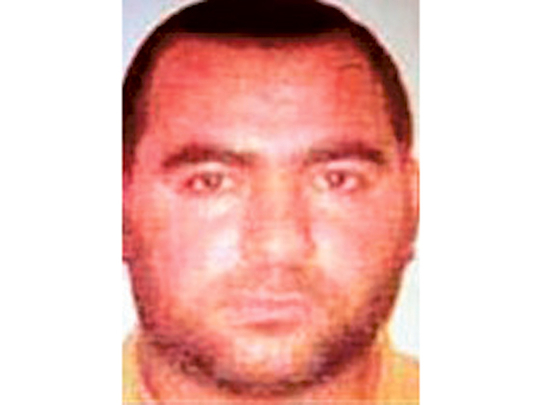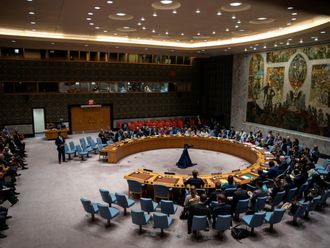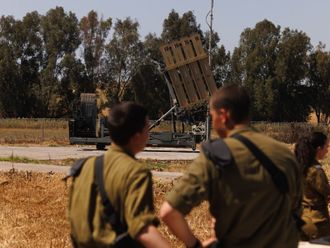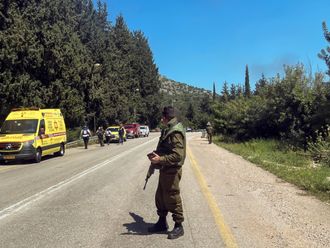
Baghdad: For all his power and newfound notoriety, there are only two authenticated photos of Abu Bakr Al Baghdadi, the man now called the world’s “most powerful jihadi leader”. One shows a man with an olive complexion and a round countenance. The other, released by the Iraqi government in January, depicts an unsmiling bearded figure in a black suit. The image is cracked and blurry, as though someone had taken a picture of a picture.
The murkiness of the picture is appropriate. The man who orchestrated the sacking of one of Iraq’s most important cities and today controls a nation-size swath of land is a relatively unknown and enigmatic figure.
Much of what is known of Al Baghdadi’s history is unconfirmed, while other information is disputed to such a degree that it’s nearly impossible to discern where fact meets Al Baghdadi’s growing myth.
Several facts, however, are clear: Al Baghdadi leads the Islamic State of Iraq and Syria (Isil), the group that evolved from the Al Qaida in Iraq organisation that US troops once fought. He appears to be a shrewd strategist, a prolific fundraiser and a ruthless killer. The US has a $10 million bounty on his head. He has thrown off the yoke of Al Qaida’s command and just took his biggest prize yet — Mosul, Iraq, a city that sits at the vital intersection of Iraq, Turkey and Syria. And in just one year of grisly killing, he has in all likelihood surpassed even Al Qaida leader Ayman Al Zawahiri in clout and prestige among Islamist militants.
“The true heir to Osama Bin Laden may be Isil leader Abu Bakr Al Baghdadi,” wrote The Washington Post’s David Ignatius. He is “more violent, more virulent, more anti-American,” a senior US intelligence official told the columnist, while the cautious and uncharismatic Al Zawahiri “is not coping well.” In fact, Al Baghdadi is now recruiting fighters from other Al Zawahiri affiliates, including Al Qaida’s Yemen branch and the Somalia-based Al Shabab.
“For the last 10 years or more, [Al Zawahiri] has been holed up in the Afghanistan-Pakistan border area and hasn’t really done very much more than issue a few statements and videos,” Richard Barrett, a former counter-terrorism chief with the British foreign intelligence service, told Agence France-Presse last week. “Whereas Al Baghdadi has done an amazing amount — he has captured cities, he has mobilized huge amounts of people, he is killing ruthlessly throughout Iraq and Syria. ... If you were a guy who wanted action, you would go with Al Baghdadi.”
Born a Sunni in 1971 in the Iraqi city of Samarra with the name Awwad Ebrahim Ali Al Badri Al Samarrai, he claims to be a direct descendant of the Prophet Mohammad (PBUH). According to a widely cited biography released by jihadists, “he is a man from a religious family. His brothers and uncles include preachers and professors of Arabic language, rhetoric and logic.” The biography and Arabic-language accounts claim he obtained a doctorate at the former Islamic University in Baghdad — which is presumably why several of his many aliases include the title ‘Dr’.
He holds degrees in Islamic studies and history and is thought to have been a preacher around the time of the 2003 US-led invasion of Iraq. The chaos of those months drove the 30-something into militancy and he formed an armed group in eastern Iraq, one that reportedly never rose out of obscurity.
The opacity of his background, analysts say, suggests a broader truth about rising Islamist militants.
“The mystery surrounding Abu Bakr Al Baghdadi — at the level of his personality, his movements, or even his relatives, his family, and those close to him — came as a result of what happened to previous leaders, who were killed after their movements were detected,” wrote Mushreq Abbas in Al Monitor. He is the “invisible jihadist,” according to Le Monde.
But the narrative solidifies in 2005, when Al Baghdadi was captured by US forces and spent the next four years as a prisoner in Camp Bucca in southern Iraq. It was from his time there that the first known picture of Al Baghdadi emerged. And it’s also there, reported Al Monitor, that he possibly met and trained with key Al Qaida fighters.
He gained enough respect that by 2010, after several leaders of the insurgent group Al Qaida in Iraq were killed, he assumed control of it. At that time, the power of the Islamist militancy in Iraq was at its lowest ebb.
But then Syria happened. The civil war there, which left a vacuum of authority in large tracts of the country, fueled a resurgence of the group. The upheaval gave rise to Isil. Over the following years, as many as 12,000 Islamist extremists — 3,000 of whom were from western countries — flocked to the region to fight, according to the Soufan Group, an intelligence consultancy.
Even then, Al Baghdadi, who today is respected among militants as a battlefield tactician, maintained his anonymity. It is said that no one knows where he is. Reports say that in the rare instances that he meets a prisoner, he wears a mask.
The rise of Isil under his stewardship has been less about a cult of personality than what one expert told AFP signalled a “transnational ideology”. This became especially clear after Al Baghdadi cast off Al Qaida’s leadership last June. “I chose the command of God over the command that runs against it in the letter,” Al Baghdadi told Al Zawahiri, who had tried to bring the rogue commander back into line.
Since then, the power of Al Baghdadi, who some say may soon establish himself as emir of a new Islamic state, has only grown, as has that of Isil.











